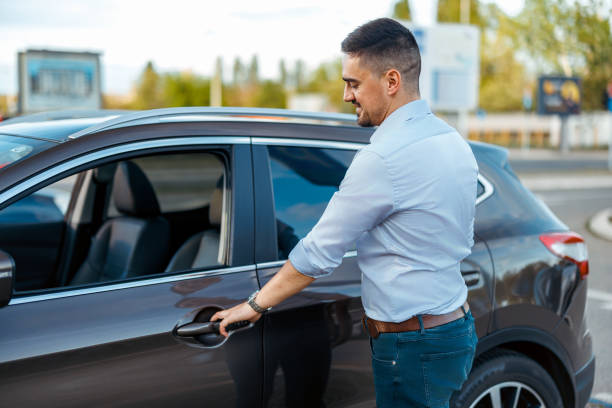Let’s be real—driving these days can feel like a battlefield. Between bumper-to-bumper traffic, people glued to their phones, and bikes weaving through city streets, it’s a miracle we all make it home in one piece. And if you live in a busy urban area, you know how nerve-wracking it can be just to parallel park without causing chaos.
But here’s the thing: sometimes it’s not the big stuff that causes trouble—it’s the tiny habits we forget. Like how we open our car doors. Sounds harmless, right? Yet that one move can change someone’s life. That’s where the Dutch Reach comes in—a small switch that could stop a serious accident before it even happens.

Why Road Safety Is a Shared Responsibility
We often talk about distracted driving and speeding, but there’s another silent danger lurking in everyday driving routines: carelessness when exiting a car.
Think about it. You park. You’re in a rush. You grab the door handle and swing it open without a second thought. But what if someone—a cyclist, a scooter rider, even a jogger—is passing by at that exact moment?
One second of thoughtlessness could lead to a serious collision. This isn’t just a driver issue—it affects everyone who uses the road. That’s why building better habits behind the wheel (and behind the door) is so important.
Video: If Somebody Hits Your Car While Opening Their Door Do this!!
What Is “Dooring”? And Why Is It So Dangerous?
“Dooring” might sound like some weird slang—but it’s actually a major hazard, especially in cities with heavy bike traffic. It happens when someone in a parked car opens their door into the path of a moving cyclist. The result? The cyclist crashes into the door—or swerves into traffic trying to avoid it.
These aren’t rare accidents. In fact, they’re so common that entire safety campaigns have formed around stopping them. Cyclists can suffer broken bones, head injuries, or worse—just because someone forgot to look first.
The worst part? Dooring is totally avoidable. That’s what makes it so frustrating—and so important to talk about.
My Wake-Up Call: A Near Miss That Changed How I Drive
I used to be guilty of the same thing. Park. Open door. Step out. No big deal.
Then one day, I was riding with a friend downtown. We pulled into a spot. He reached for the handle. I happened to glance over—just in time to see a cyclist flying toward us.
My heart stopped. My friend opened the door just a second before the bike reached us. The rider swerved, barely dodging the edge of the door, and almost collided with a passing car instead.
It was terrifying. It shook both of us. That moment could’ve turned tragic. And it stuck with me.
Enter the Dutch Reach: A Simple Move with Huge Impact

So, what exactly is the Dutch Reach?
It’s a method developed in the Netherlands, a country where biking is a way of life. Instead of using the hand closest to the door to exit your car, you use the hand farthest away. For drivers, that means your right hand. For passengers, it’s your left.
This motion naturally makes you twist your body. You turn your shoulders, your head follows, and you’re suddenly looking backward—right where a cyclist would be coming from.
That tiny twist? It gives you a clear view before you open the door. It’s so simple, yet incredibly effective.
Why It Works: Muscle Memory Meets Mindfulness
Video: How do you open your car door?
The brilliance of the Dutch Reach lies in its simplicity. You’re not being asked to memorize complicated rules or download another app. You’re just retraining your muscle memory.
At first, it feels weird. Your body wants to default to what’s familiar. But after a few days, the Dutch Reach becomes automatic. You don’t even think about it—it just happens. And that’s exactly the goal.
It’s like buckling your seatbelt. Once it’s a habit, it feels unnatural not to do it.
Passengers Matter Too: Everyone Has a Role
Don’t assume this is just the driver’s job. Backseat passengers, front seat riders—everyone in the car should be using the Dutch Reach.
Kids can be taught early. Teenagers can make it part of their driving lessons. Even rideshare passengers can adopt the habit. Because cyclists pass parked cars on both sides, not just the driver’s side. Everyone plays a part in preventing these incidents.
One second of awareness could save a life. And one person’s good habit could inspire others to follow suit.
Changing the Culture: Making the Dutch Reach the Norm

So how do we spread this life-saving practice?
- Driver’s Ed Programs should teach it as a default technique.
- Cities can include it in bike safety campaigns, with signage on busy streets.
- Car manufacturers could even highlight it in user manuals or onboard infotainment systems.
- Parents can pass it on to young drivers in the household.
The more we talk about it, the more normal it becomes. And when a good habit becomes part of the culture, that’s when real change happens.
Right Hand. Look Back. Save a Life.

If you take away one thing from this, let it be this: next time you’re about to open your car door, stop. Use your far hand. Turn your body. Look.
It’s that easy.
Road safety doesn’t always require laws or fines or fancy tech. Sometimes it just takes a shift in the way we think—and a small, consistent change in how we act.
The Dutch Reach isn’t just a quirky European idea. It’s a simple move with the power to prevent pain, protect people, and create a safer, more mindful way to share the road.
So make it a habit. Share it with others. And the next time someone asks, “What’s the Dutch Reach?”—you’ll have the perfect answer.


